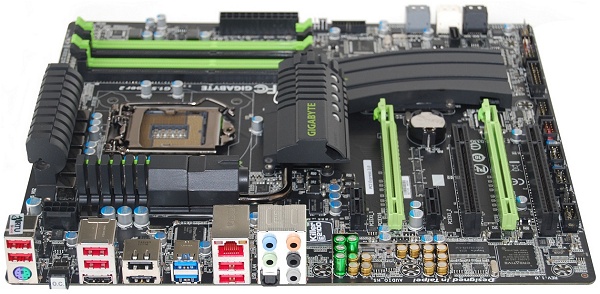Gigabyte G1.Sniper2 Motherboard Review > Design & Layout - stilesthicaltat
Design & Layout
The G1.Sniper2's matte blackness PCB gives it a unique appear, as does its black and K ingredient design. Aesthetics aside, we have nobelium real complaints about the board's layout. Perhaps the only issue with the design is its placement of the DIMM slots and CPU socket, which are all but on top of each other.


The G1.Sniper2 features an eight-phase power design that utilizes scummy core get-up-and-go loss Ferrite Nub Chokes as well A Modest RDS(on) Driver-MOSFETs. These components are same to handle a high current load while offering improved office efficiency and lower operative temperatures. Each power phase of the motherboard has three main components, ane choke, one capacitor and one MOSFET.

Gigabyte has also enclosed its Multiple Power Shift design, which is meant to maximize the control board's lifespan. When Dual Power Shift is activated, 2 sets of four power phases operate in bicycle-built-for-two, automatically enabling unmatchable set of four phases and disabling the opposite four, allowing the inactive set to rest.

Unlike a traditional power design where some phases can fail prematurely because they'rhenium always in surgical procedure, Dual King Switching ensures that each set of phases share the workload, effectively doubling their life.
Some other unique feature of G's Dual Power Switch is that if unmatchable of the power phases fails, the motherboard leave mechanically disable its chemical group of four phases and keep on operational with the some other coiffur. With traditional motherboards, if one power phase fails, the board becomes a paperweight.


Cooling the eight-phase power design are two double heatsinks, one of which is connected to a bigger heatsink victimisation a 6mm heatpipe. The bigger heatsink is settled where you'd typically bump the northbridge.


However, because the Z68 chipset has been used there is no northbridge, meaning this heatsink ISN't chilling anything. The Z68 is cooled by the smaller heatsink that resembles an ammunition magazine.


The two PCI Verbalize x16 slots (color-coded greens) are separated by two other expansion slots, providing flock of room for air flow between SLI or Crossfire setups. While the primary slot offers x16 bandwidth, the secondary slot is electrically pumped-up for x8 speeds because the Z68 crapper only support plural graphics cards in an x8/x8 configuration.

Gigabyte has mounted the cardinal SATA ports at a 90-degree weight behind the second gear and third PCIe x16 slots to avoid conflicts with postgraduate-end art cards, which typically pair the length of a motherboard. A seventh slot is positioned vertically and is designed to connect to a supercharged first panel eSATA larboard.

The four DDR3 DIMM slots have also been placed distant enough away from the primary PCIe x16 slot, which is important on an enthusiast board. As we've seen with other Gigabyte boards, the G1.Sniper2 places its CMOS battery between the PCIe x16 slots, making it trying to access, and it's worth mentioning that there's no CMOS clear switch on the board's I/O panel.

Public speaking of which, the rear interface panel is inhabited by a single PS/2 port for legacy keyboard and mouse plump for, seven USB 2.0 ports, two USB 3.0 ports, an eSATA port, HDMI-exterior, Ethernet, five audio jacks, S/PDIF optical/digital connector and an OC button.
Source: https://www.techspot.com/review/432-gigabyte-g1-sniper2/page3.html
Posted by: stilesthicaltat.blogspot.com






0 Response to "Gigabyte G1.Sniper2 Motherboard Review > Design & Layout - stilesthicaltat"
Post a Comment